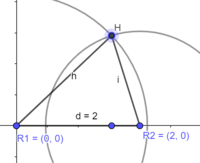BigBallerJMan
New member
- Joined
- Nov 30, 2019
- Messages
- 3
Hello all
I've been working on this problem I can't wrap my head around.
I have a certain object H moving through a 2D plane at a constant velocity v, at an unknown angle from two recievers R1 and R2. The distance between H and R1 and H and R2 is h and i respectively. Using Doppler's effect and other math I won't get into, I know [MATH]\frac{\mathrm{d} h}{\mathrm{d} x}[/MATH] and i know [MATH]\frac{\mathrm{d} i}{\mathrm{d} x}[/MATH], while I do not know the actual value of i and h.
Given that H is travelling at a constant velocity in a single direction, I would like to extract some sort of information from the situation for a given [MATH]\frac{\mathrm{d} h}{\mathrm{d} x}[/MATH] and [MATH]\frac{\mathrm{d} i}{\mathrm{d} x}[/MATH]. I imagine I'd be able to extract some sort of relationship between h and i or some parametric equations for the coordinates of H.
For the moment I've tried mapping H as the point of interesction of two circles with changing radius h and i, but it hasn't brought me anywhere.
Any help is greatly appreciated.

I've been working on this problem I can't wrap my head around.
I have a certain object H moving through a 2D plane at a constant velocity v, at an unknown angle from two recievers R1 and R2. The distance between H and R1 and H and R2 is h and i respectively. Using Doppler's effect and other math I won't get into, I know [MATH]\frac{\mathrm{d} h}{\mathrm{d} x}[/MATH] and i know [MATH]\frac{\mathrm{d} i}{\mathrm{d} x}[/MATH], while I do not know the actual value of i and h.
Given that H is travelling at a constant velocity in a single direction, I would like to extract some sort of information from the situation for a given [MATH]\frac{\mathrm{d} h}{\mathrm{d} x}[/MATH] and [MATH]\frac{\mathrm{d} i}{\mathrm{d} x}[/MATH]. I imagine I'd be able to extract some sort of relationship between h and i or some parametric equations for the coordinates of H.
For the moment I've tried mapping H as the point of interesction of two circles with changing radius h and i, but it hasn't brought me anywhere.
Any help is greatly appreciated.

